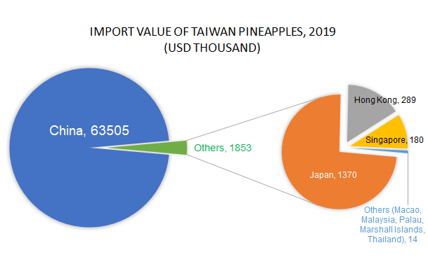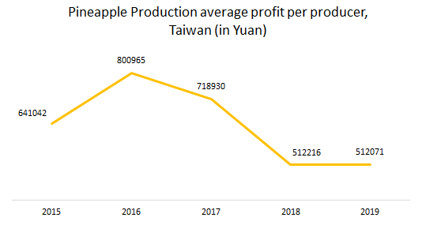Taiwan's pineapple not so fine-apple
On February 26, 2021, China announced an import ban on Taiwan pineapple effective starting March 1, 2021, justified as biosafety measures due to “harmful” mealybugs found in several imported batches of Taiwan pineapples in 2020 (also look at relevantMarket Comment). The abrupt and possibly politically motivated trade sanction has turned Taiwan’s sweet tropical fruit producers bitter. However, Taiwan’s government snapped back, claiming the import ban is a political agenda that intimidates and makes Taiwan concede to becoming a province of China. Indeed this issue has sparked intense diplomatic tensions for decades. China denied these accusations and convicted Taiwan for misconstruing words to damage its reputation. Nonetheless, the import ban's impact is non-negligible as more than 90% of Taiwan’s pineapple exports have been destined to China for several years. In 2019, China imported USD 63 million worth of pineapples, constituting 97% of Taiwan's total pineapple export. Other countries such as Japan, Hong Kong, and Singapore only account for 3% of its pineapple exports. China’s sudden departure leaves a significant hole in Taiwan’s pineapple industry.

Source: Tridge, ITC Trade Map
Current Situation
With pineapple serving as a significant economic contributor and a symbol of resilience against China, the Taiwan government is calling for support from its citizens and international allies under the slogan “Freedom pineapples”. To alleviate the damage caused by China’s import ban, president Tsai Ing-wen promised USD 36 million in aid to Taiwan pineapple farmers, especially with the continuously declining profit of pineapple producers, which reached its lowest point in 5 years in 2019. Mr. Chen Chi-chung, the minister of the Council of Agriculture, announced that the council is working towards stabilizing pineapple prices by attracting extra orders of up to 30k MTs from Singapore, Japan, the US, Australia, and Vietnam with sales and trade incentives. According to a Tridge expert trader, the Taiwan government is offering freight subsidies to registered export companies in Taiwan. Specific freight aid amounts are as follows:
Australia via air: USD 3.75/kg
Australia via ocean: USD 0.82/kg
Middle east via ocean: USD 0.54/kg
All others: 0.43USD/kg
President Tsai also encouraged its citizens to purchase more pineapples and in just four days, Taiwanese businesses and consumers have almost filled the gap left by China by buying an entire year’s worth of pineapples.

Source: Tridge, Taiwan Agriculture and Food Administration
Impact on Pineapple Prices
Taiwan
Although this year’s pineapple production has been salvaged by massive orders from its local businesses and consumers, Taiwan continues to expand its trade partners to diversify its export market as it can no longer export to its biggest consumer, China. The Canadian Trade Office and the American Institute in Taiwan have shown support for Taiwan pineapples through Facebook posts, flexing the high-quality of Taiwan pineapples. In fact, the US is the largest pineapple importer in the world. It absorbed 26% of the world pineapple export market in 2019, mainly importing from Costa Rica. Taiwan has not been exporting to the US, but that may change with Taiwan’s national support in promoting its pineapples. However, with a huge hole left by China, the pineapple market may experience a downward price trend for the succeeding seasons, especially when the current high domestic demand doesn’t hold.
China
Contrary to the sour Taiwanese pineapple producers, China's pineapple farmers exclaimed in joy as orders doubled just a day after the import ban announcement. China is actually a larger pineapple-producing country than Taiwan, and in 2019, the country produced 33 times more than the amount it imported from Taiwan. Even with a gap left by Taiwan, about 30% of China’s pineapple imports in 2019, China isn’t expected to experience a substantial shortage. Still, pineapple prices may experience a slight upward pressure if other exporting countries don’t fill the gap.
Sources
- Business Standard. China at new low, bans Taiwan grown Pineapples; people call for support
- Reuters. Prickly problem: Taiwan says won’t be beaten by China pineapple ban
- Reuters. U.S., Canada hail Taiwan’s ‘freedom pineapples’ after Chinese ban
- Taiwan News. Taiwanese buy entire year’s worth of pineapple exports to China in 4 days
- Taiwan Agriculture and Food Administration. Pineapple production profit.





